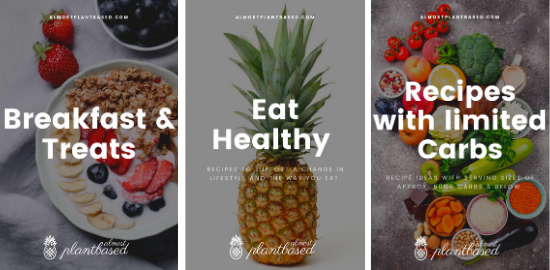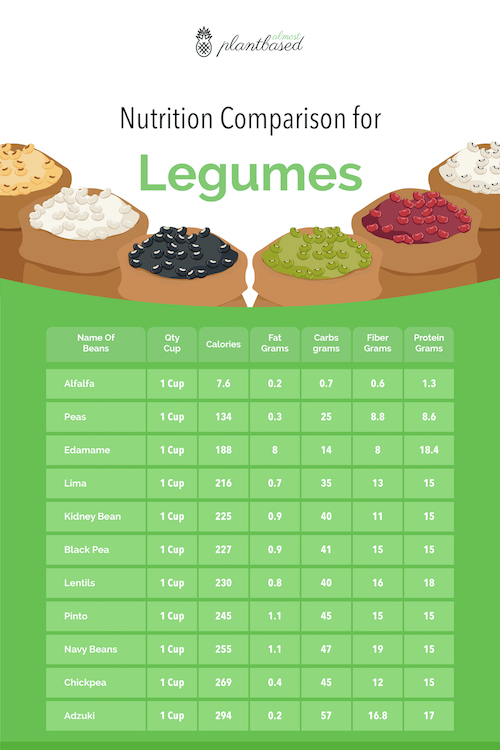Last updated on February 7, 2022 at 01:20 pm
Before we compare the 11 healthiest beans and legumes let us tell you why we believe they are the healthiest food to date.
They are packed with nutrients, full of fiber, proteins, and taste absolutely delicious. In addition, their super versatile nature enables them to be used in almost all kinds of cooking techniques.
If you are looking to build a healthy eating regimen, you must add legumes or beans to your diet.
Legumes are common ingredients for cooking in all cultures of the world. They are available in different shapes, colors, sizes, textures, and tastes. Not only are they brimming with goodness, but they are also a great way to build up a healthy eating regimen.
When compared to other foods like red meat and sugar-filled foods, legumes are 100 percent better and really incomparable.
Legumes and Beans – Are they the Same?
While this seems like a fairly simple question, it is complicated.
The definition of legumes is a pod or seed of the plants belonging to the Fabaceae family (sounds Italian).
They are the largest plant family consisting of 751 genera and over 19000 known species.
Now, back to the question, are legumes beans? Not all legumes are beans, but all beans are classified as legumes. If it can split into two, it is a bean and a legume.
Scientifically, legumes are any type of fruit developed from a simple carpel (the carpel us the female reproductive organ in a flower)
So much for an explanation!
Simply put, beans are the seeds produced by most leguminous plants that are useful as food to man and animals.
History of Legumes
Legumes are the oldest cultivated plants in the world. They are believed to be domesticated by the early humans for food, feed, and foliage as far back as 7000 BC in the Neolithic age.
Legumes were also cultivated around 4000 BC in Switzerland and in China more than 3000 years ago.
The earliest record of legumes was 37 BC in the Roman Empire where it was used for pasture and to cover the farmland to prevent it from drying out or losing the top nutrients.
Planting, harvesting, and storing legumes are very easy as they grow on almost all kinds of soils with little or just enough water. Planting season starts in the summer and is harvest before winter begins or in other parts of the world when the dry harmattan wind starts to blow over.
The beans are picked before it begins to dry out for freshness or allowed to dry out completely. The beans are removed from their pods and stored in silos or huge bags. Asides from pests like weevils that affect beans, it will keep in an airtight container for months.
Why add the Healthiest Beans & Legumes to your Diet?
Legumes are rich in lots of nutrients ranging from zinc, iron, sodium, potassium, fiber, with zero and a negligible amount of fat. This makes them a rich addition to your diet and a great way to lose weight, reduce the risk of cancer and heart-related disease, improve digestion, stop constipation, and cell repair ad growth.
Legumes have next to zero sugar, but that does not hinder that delicious taste, especially when cooked. It takes well to flavors and just melts in your mouth. Eating beans as part of your diet, reduced craving, binge eating, and increases your level of hydration.
For diabetics, the low glycemic index of beans makes it the best addition to their diet.
According to the American Diabetes Association, adding a cup of legume to your diet will change your health status and improve your blood sugar.
Health Benefits of Legumes
One-quarter cup of legume has the same protein as a piece of beef steak or chicken. Legumes are not just a healthy choice because of what they contain; they are an excellent choice packed with nutrients. We eat food for their nutritional value, and legumes are superfoods at the top of the food triangle.
4 Benefits of Eating Legumes
1: Lose Weight
If you are thinking the carb content is high, do not worry. Legumes contain complex carbs that are good for your body; they provide you with the right amount of fuel to power you through the day without affecting your blood sugar.
Furthermore, almost half of the net carb in legumes is the fiber that supports metabolism, digestion to help you shed the pounds. In addition to the high protein and fiber value, legumes’ low glycemic index enables then to curb food cravings and satisfy you for long.
People who eat legumes for breakfast are shown to drink more water throughout the day than other diets because of the high fiber content. Now you can stay healthy and stay hydrated at a go just by adding legumes to your diet.
2: Improve Heart Health
Legumes are rich in magnesium and potassium, two important minerals that help your heart. These minerals will reduce your risk of heart-related diseases like hypertension, clogged arteries, and heart attacks.
Legumes’ ability to improve good cholesterol levels in the body makes them a heart hearty choice to help you maintain normal blood pressure, prevent inflammation, and others.
3: Improve Colon Health and Digestion
The high fiber content in legumes adds bulk to your waste and enables easy movement down the colon.
It also play another role, it helps to clean the intestines and an excellent diet for people with irritable bowel syndrome and constant constipation.
If you always suffer from food allergies or have stomach upset after eating, adds legumes to your meal and see a difference.
4: Maintain Healthy Insulin Levels
Adding legumes to your diet stabilizes the sugar level, and prevents any sugar spike that could have been caused by other food class in your meal. Legumes slow down the rates of sugar absorption into the bloodstream to prevent sugar spikes.
5: Proteins, Proteins, Proteins!
Proteins all the way – think of omitting meat in your diet, legumes are the perfect replacement for you.
They are rich in protein and offer more nutritional value to you than meat can or will.
Cooking with Legumes
Legumes can be made into anything – paste, powder, slurry, roasted, eaten whole, added to salads, and many more. They are so versatile and blend well with most dishes regardless of culture; you will never lack a recipe with beans.
Except you purchase a can of beans in liquid, beans are usually a dry nut to crack. It is hard and takes a long time to cook. If you have a crockpot or pressure cooker, add your entire ingredient, add the beans and allow it to cook overnight or over several hours.
You can soak them too and enjoy the sprouts or blend into a paste for thickeners in food.
You get access to more than 200 recipes in our nutrition and weight loss courses, which you can check out HERE.
The 11 Healthiest Beans and Legumes
#containsaffiliatelinks
1: Alfalfa
These are a popular legume believed to have originated from Asia and the Middle East. This plant belongs to the legume family and used as forage and herbs. Alfalfa is best eaten when it has sprouted; soak the seeds for a period of 3 to 5 days until they sprout. The sprouts have a great crunch, sweetness, and full of protein, vitamins, and minerals. Adding alfalfa to your diet will help manage blood sugar and cholesterol levels.
2: Navy Beans
Navy beans are your best way to beat metabolic syndrome. These legumes are the richest source of fiber, with almost 19 grams in 182 grams of the bean. This high fiber and protein content makes it the best for weight loss and digestive health. Navy beans are full of minerals and vitamins, including folate and Vitamin B-complex for muscle growth, and blood sugar stabilization.
3: Adzuki
Also known as mung bean, Adzuki is a legume cultivated in Asia. It is also a significant part of their cooking and is made into a paste or eaten alone. The adzuki beans are deep red colored legumes with a variety available in gray, black, and white. The bean has high carb content but is packed with protein, fiber, and macronutrients great for the body. This very low-fat legume improves digestive health and constipation. It is also easy to cook, digests fast, and absorbs slowly into the body increasing satiety and decreasing hunger and cravings.
4: Peas
Peas are gradually gaining more recognition as a plant-based food with immense health benefits. They are also super healthy and packed with flavor and sweetness from the high sugar content in them. One cup of fresh peas or 160 grams contains 9.5 grams of sugar. Whether you are eating them fresh, making a paste out of the blanched peas, or using the flour, it is vitamins and mineral good for the heart, including vitamin C, Vitamin K, and manganese. When compared to other legumes, they have the lowest calories but not to alfalfa.
5: Pinto Beans
Are you looking for the perfect legume to lose weight, improve bowel movement, boost healthy cholesterol, and provide the necessary micro and macronutrients during pregnancy? It is PINTO.
Pinto is a legume that makes beautiful delicacies in Mexico where they are eaten whole, mashed, or fried. Their high protein and fiber content makes them a good choice for people who want to lose weight or curb irritable bowel movement.
6: Lentils
Lentils are a staple in Indian cuisine, this legume pods look like small flattened prescription pills and is available in green, black, red, and brown. Lentils have high fiber and protein content in a cup. Their affordability, easy to cook nature, compatibility with different flavors makes them a favorite for so many. This heart-healthy legume will boost weight loss, reduce your risk for heart disease, lowers, and maintain blood sugar levels, and is super delicious.
7: Black Beans
Lower your blood sugar, and improve cholesterol levels with black beans diet. Black beans also contain high levels of folate, which is good for pregnant women and their babies. This macronutrient is heart-friendly and is said to lower your risk of heart-related diseases. Black beans have high carb content, but the fiber and protein level create the perfect balance for a delicious meal.
8: Chickpeas
Whether you call them chickpeas or garbanzo beans, these make a great addition to your meal. This heart-healthy bean will reduce cholesterol level, aid weight loss, and help douse the effect of your blood sugar hitting the roof. It is high fiber and protein to boost digestion, increase added to salads or in food soups as a thickener. It is satisfying and boosts good LDL cholesterol. It is used in hummus,
9: Kidney Beans
Whether dried or canned, their shape and color make them distinct. Kidney beans are a perfect staple added to rice or salads to make a complete meal. The beans have loads of minerals that are good for the heart, bones, and brain.
10: Lima Beans
Lima beans, also known as butter beans, are usually only found during the summer season. This beans native to South American has been a component in the cooking of people in Peru for the past 7000 years. The creamy, buttery texture and sweet taste are a reason why many people adhere to it. Overall, they have high protein and fiber content to boost health and longevity among consumers.
11: Edamame
These are the young, immature legume of soybean and the Japanese word for steamed beans. They still contain moisture and are a great way to snack on something crunchy without any sugar spike. Edamame can be added to cooking, boiled, steams, or stir-fry. They have a subtle sweetness to them and are packed with fiber. It is not to be mistaken with sugar snap peas, these are thicker and plump. Edamame makes a good appetizer or complement and has lots of health benefits.
The Bottom Line
Legumes are superfoods and must-have in your pantry. Their incredible versatility and adaptability with plenty of health benefits are only some reasons to add them to your diet.
In our nutrition and weight management programs we talk about legumes and other foods to eat and to avoid when looking at a healthier nutrition that controls your weight in the same time. Find out more about our programs HERE.




Leave a Reply